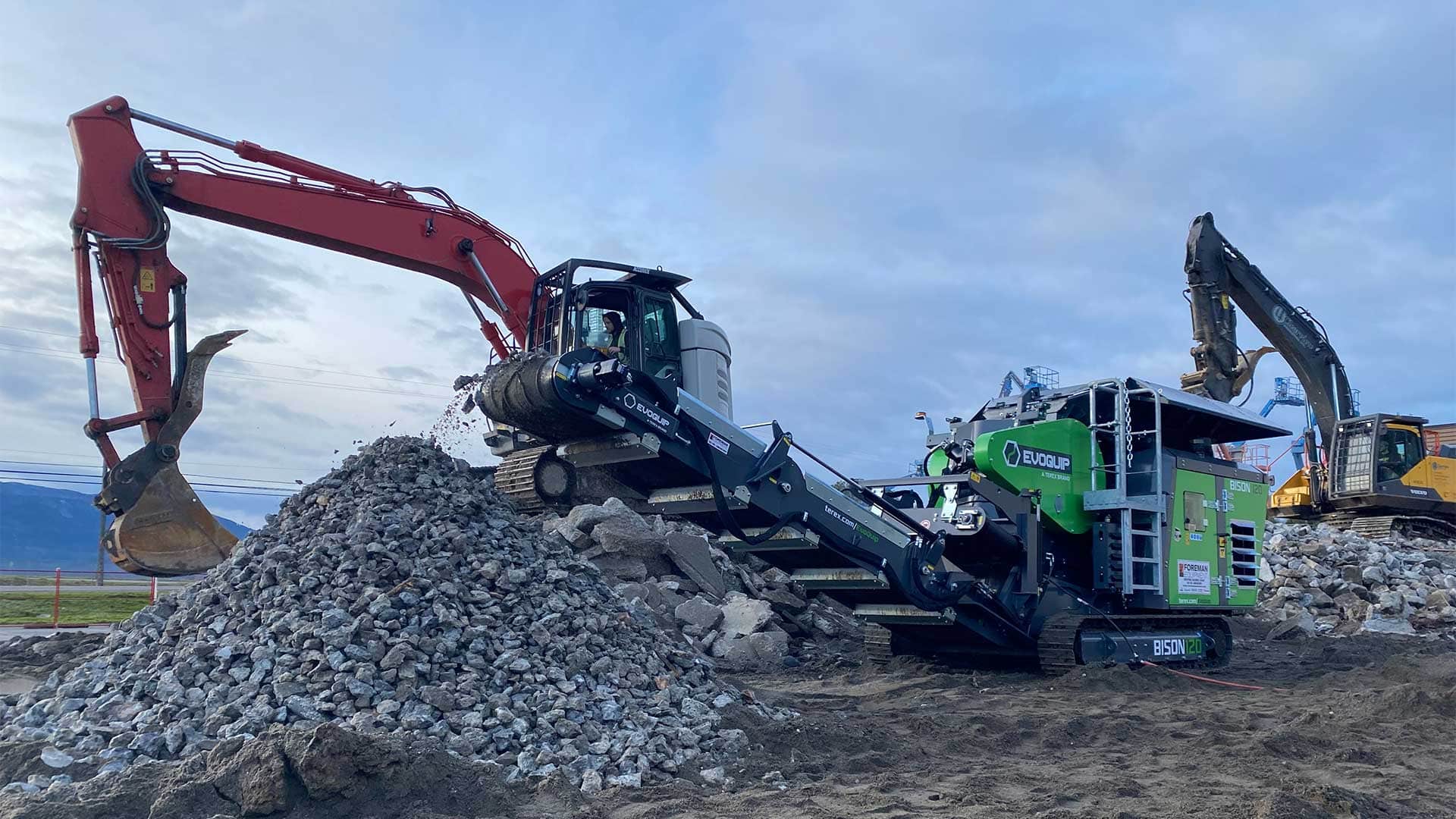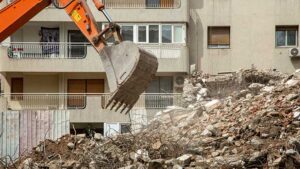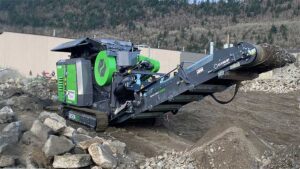
Turning What was Once Waste Into Wealth is Becoming Mainstream.
A Mountain of Waste That Keeps Growing
 Look around any construction site, and you’ll see the same story—piles of rubble, stacks of broken concrete, and heaps of discarded materials. It’s been this way for decades. The construction industry generates about a third of the world’s total waste and contributes 40% of global carbon emissions (Miller, BBC 2021).
Look around any construction site, and you’ll see the same story—piles of rubble, stacks of broken concrete, and heaps of discarded materials. It’s been this way for decades. The construction industry generates about a third of the world’s total waste and contributes 40% of global carbon emissions (Miller, BBC 2021).
For years, the solution was simple: haul it away and dump it in a landfill. Out of sight, out of mind. But that old way of thinking is catching up with us. With landfill costs skyrocketing, environmental regulations tightening, and natural resources running low, we can’t afford to treat valuable materials as trash anymore.
The Hidden Costs of Doing Nothing
Let’s be real—ignoring this problem isn’t just bad for the planet, it’s bad for business.
- Landfill costs are out of control. Many regions are hiking up disposal fees, making dumping waste an expensive mistake.
- Resources are getting scarce. Extracting new materials takes a toll on the environment and your wallet.
- Reputation matters. More clients are looking for sustainable building practices, and companies that don’t adapt risk losing contracts.
- We’re leaving money on the table. Every ton of ‘waste’ that gets tossed could have been recycled and resold.
But here’s the good news: we don’t have to keep doing things the old way. The solution is already here.
Turning Construction Waste into High-Value Materials
Recycling demolition and excavation debris isn’t just an option anymore—it’s a smart business move. Instead of paying to dump materials, we can process and resell them for new construction projects.
 How Does It Work?
How Does It Work?
- Sorting the Good from the Bad – After demolition, materials like concrete, asphalt, brick, wood, and metal are separated for recycling.
- Crushing and Screening – Concrete and asphalt are broken down into smaller, usable pieces through crushers and screens.
- Washing and Quality Control – Recycled materials are cleaned and tested to make sure they meet industry standards.
Giving Old Materials a New Life – The processed materials are then used in roads, foundations, and even brand-new buildings.
The Benefits of Recycled Aggregates
Saves You Money
- Lower material costs – Recycled aggregates are cheaper than buying new ones.
- Cuts landfill fees – Less waste means fewer expensive trips to the dump.
- Generates revenue – Selling high-quality recycled materials can become a new income stream.
Helps the Environment
- Reduces the need for mining – Preserves natural resources and prevents habitat destruction.
- Lowers emissions – Less extraction and transportation mean a smaller carbon footprint.
- Keeps landfills from overflowing – Every recycled ton keeps waste out of our already packed landfills.
What Can We Recycle?
Recycled aggregates aren’t just a backup plan—they’re high-quality materials that get used in major projects:
- Crushed concrete & asphalt – Ideal for roads, driveways, and foundations.
- Recycled sand – Used for concrete production, pipe bedding, and landscaping.
- Topsoil from construction sites – Perfect for landscaping and site rehabilitation.
- Recycled metals – Melted down and repurposed into new building materials.
- Recycled asphalt – Saves money by reducing the need for new asphalt oil.
The Time to Act is Now
The construction industry is changing fast. Cities are demanding greener projects, clients want sustainable materials, and businesses that embrace recycling are getting ahead of the competition. Companies that invest in recycling today will be the ones leading the industry tomorrow.
Ready to Turn Waste into Opportunity?
If your company deals with construction waste, it’s time to rethink how you handle it. Recycling isn’t just the right thing to do—it’s the smart thing to do. Lower costs, new revenue streams, and a greener reputation are just the beginning.
Want to learn more about our recycling solutions? [Let’s talk] and find out how we can help you turn waste into wealth.
Blog
The Environmental Benefits
The environmental benefits of recycling construction waste into usable aggregate are immense. Firstly, it dramatically reduces the volume of waste that ends up in our landfills, thus conserving valuable space. Secondly, it reduces the need for raw material extraction, thereby preserving natural resources and habitats. This also reduces transportation and production energy, minimizing our carbon footprint.

Explore the Foreman Advantage to getting the most from your recycling.
Natural Aggregates vs Recycled Aggregates
What are Natural Aggregates
Natural aggregates are available in different types depending on their uses. They consist of crushed or uncrushed materials like sand, gravel and rock from natural sources like riverbeds and glacial deposits. The material is often used to produce concrete, asphalt and base gravel for infrastructure like roads and buildings.
Using recycled aggregates has environmental benefits, including:
- Conserving natural resources by decreasing the demand for virgin materials
- Protecting local ecosystems and maintaining biodiversity level
- Reducing energy consumption, transport emissions and disposal of waste to landfill
- Reducing road haulage activities and decreasing road congestion, and increasing road safety
Using recycled aggregates has financial benefits, including:
- Producing recycled aggregate for resale is more cost-effective than sending unwanted materials to landfill and incurring landfill tax and transport costs.
Material Sources / End Products & Uses
C&D Waste
Material derived from the demolition of buildings (High % of concrete, brick, wood, plastics and metals)
Road, Sidewalk and Infrastructure Construction
Sidewalks, roads and other infrastructure are all made of concrete and asphalt, which can be crushed, screened and processed to make new concrete and asphalt mixes. Recycling asphalt also significantly saves asphalt oil when used in new mixes.
Vacuum Truck / Site Excavation
Material derived from excavating construction sites. (The gradation is variable and often contains a high percentage of silts & clays (63 microns)
Trommel Fines
Dry recycling residual fine materials. (Often containing high percentages of wood, plastics and organic matter)
Road Sweepings
Material derived from road sweepers/vacuum trucks often contains a high percentage of plastic and organic matter.
Contaminated Waste / Soil
They are categorized as Non- Inert due to the presence of heavy metals and hydrocarbons. (Eg. Material excavated after an oil spill or earthen material from chemical works)
Concrete Truck ‘Washout’
Concrete returned to the ready mix depot, which was surplus to requirements on site.
What Recycled Materials Are Used For:
Sized Aggregates
- They are used as Base Material for roads, pathways and drainage.
- Top Soil recycled from construction sites, this clean inert multi-sourced topsoil is suitable for landscaping on commercial or industrial building sites.
Metals
- They are used for new ferrous and non-ferrous metal products.
Recycled Washed Aggregates
- They are used for concrete and asphalt products, drainage, landscape stone, and pipe bedding.
Recycled Washed Sands
- They are used for concrete products, pipe and cable bedding and landscape brick bedding.
- Reject sand can be sold as fill material or blended into soils and compost for landscaping projects.
Take the Leap Toward Sustainable Construction Today!
Start recycling demolition waste into valuable aggregate material and reap the benefits. Get started now!

 How Does It Work?
How Does It Work?